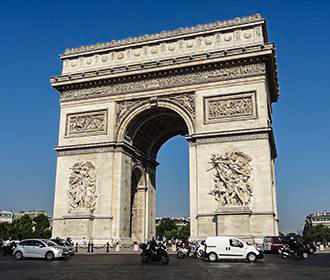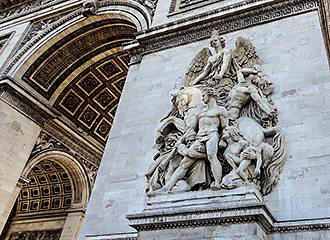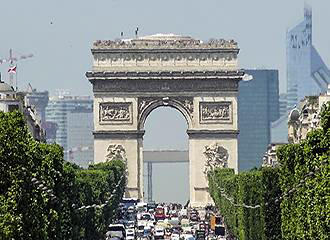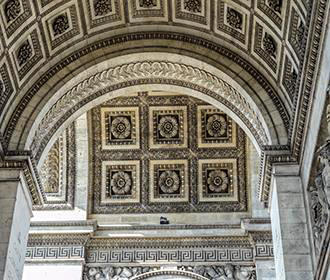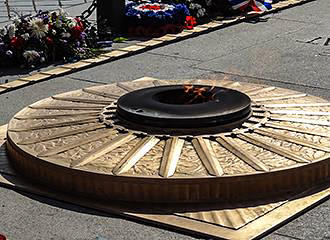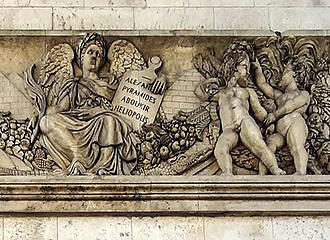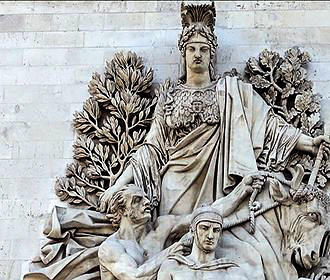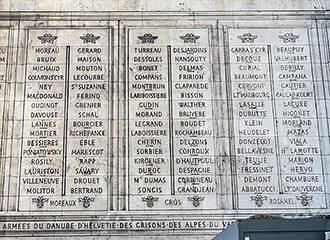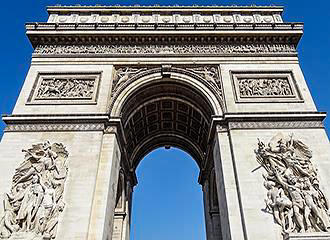Paris Arc de Triomphe at Place Charles-de-Gaulle
There are numerous different Paris monuments that you can visit and many of these monuments were built well before the most well known and famous Paris landmark, the Eiffel Tower, so if you want great views or something completely different but still with lots of history, then a visit to the Paris Arc de Triomphe is a must.
Known as a triumphal arch, after the Battle of Austerlitz, it was the idea of Napoleon I to have a magnificent arch built as a major Paris monument to honour the victories of his Grande Armee, and the grand arches of ancient Rome was his inspiration for its construction.
But do not get confused, as there are actually two triumphal arches in Paris and both were commissioned by Napoleon I, with the first being the Arc de triomphe du Carrousel and the second, being far larger, more impressive and the most famous monument, is located on the Place Charles-de-Gaulle formerly known as Place de l’Etoile and hence why it is sometimes called Arc de Triomphe d’Etoile.
There is also a fascinating history of the Arc de Triomphe right from the start, yet alone the history of the unknown soldier and the fact that this incredible Paris monument is a venue for national events that take place in Paris. And one such event, is the military parade held on 14th July each year that starts from the Paris Arc de Triomphe down the most well known avenue in the world, the Champs Elysees. Also, this is a major Paris landmark for those on the famous Tour de France cycle race, as they know they are near the finish line on the Champs Elysees when this triumphal arch comes into view.
Now the Paris Arc de Triomphe at Place Charles-de-Gaulle having its incredible and very impressive size of almost 50 metres high, 45 metres long and 22 metres wide, you can get fabulous views from the top down the Champs Elysees, to the Eiffel Tower and to the newer Grande Arche in La Defense business district of Paris in the Ile de France region.
Tourist information on Paris Arc de Triomphe
Now when you get to the Arc de Triomphe the first things you will see are of course on ground level..
Standing against the pillars are sculptures in high relief such as the Marseillaise that depicts the rising of 200,000 men in 1792 to defend France and the Departure of the Volunteers opposite the Champs Elysees.
Engraved on the inside walls of this triumphal arch are the names of generals and battles that were conducted by France during the Empire plus the French Revolution right up until 1895. Also you will get to see the names of soldiers on tablets that bear the palms and crosses of the L’Egion d’Honneur, which by the way, is the highest medal come decoration in France that was introduced by Napoleon I.
But on the ground itself there are further inscriptions that are there to commemorate other events that happened in France such as the return of the Alsace region and the Lorraine region to France in 1918 others to commemorate those soldiers who died for France during World War II, the IndoChina war, etc.
There is also the tomb of the unknown soldier buried underneath the arch with its eternal flame. Yet when you look up, you see the triumphal arch that was inspired by Titus, but in a single arch rather than having columns with the highest arch being reserved for the victor.
Going into the building itself and up to the first level there is a small museum and it is in this attic room that there have always been architectural and sculpted models since the year 1834.
However, there are now different sections that you can visit and you can get to see the bronze palms on the walls that pay tribute to the Unknown Soldier, the history of the construction work, the different events that have taken place at the Paris Arc de Triomphe and the sculptures.
There is actually a mezzanine at the top of the entablature, which can be reached by climbing 284 steps and this really does provide spectacular views over Paris and the madness of the amount of vehicles negotiating around the Place Charles-de-Gaulle square. But getting back to the views, you can obviously see the Champs Elysees, but also the Eiffel Tower, The Louvre Museum, the Place de la Concorde with the Luxor Obelisk and many more landmarks in Paris.
By the way, something we did not know ourselves, is the fact that an entablature basically crowns the very top part of a monument and consists of architrave, cornice and frieze, which is a band beneath the cornice that is designed to be decorated. And in the instance of the Paris Arc de Triomphe, the frieze depicts the departure of French armies and their return from Egypt and Italy.
Visiting the Paris Arc de Triomphe
The Paris Arc de Triomphe is located on the busiest and probably most renowned square in Paris that has 12 intersections with each of the avenues radiating from it named after battles like Wagram or famous people like Kleber.
Designed by the architect Hittorff upon the instructions of Baron Haussmann, originally the square was called the Place de l’Etoile, when it was completed in 1869, but was then renamed the Place Charles-de-Gaulle after the statesman of the same name, and this is the name it still has today, yet is often referred to as The Star because of its configuration or by a full name of Charles de Gaulle - Etoile.
However, you will be pleased to know that you do not have to try and negotiate the traffic at these intersections in order to visit the Paris Arc de Triomphe whilst you are on holiday in Paris. There is in fact an underground passage for people to avoid the busy roads and get to this monument safely, which is located on the Avenue de la Grande Armee and can be accessed from the Wagram Metro station. Another passageway is also on the Avenue des Champs-Elysees that you can utilise, which will take you to the base of the Arc de Triomphe.
When it comes to Paris public transport, you can get to the Paris Arc de Triomphe via the Metro station Charles-de-Gaulle-Etoile on lines 1, 2 and 6 the RER station Charles-de-Gaulle-Etoile on line A. Additionally, the Paris bus lines 22, 30, 31, 52, 73, 92 and 341 along with the Noctilien night bus lines N11, N24, N53, N151 and N153 will all get you within a short walk of this Paris monument, not forgetting the sightseeing tour buses like Paris Tootbus Tours.
There are now three floors that you can visit, which include the small museum and the permanent exhibition that even has interactive touch screens, along with the mezzanine and a gift shop. Plus, as of 2017 there was also a lift, or elevator, put in place and the Paris Arc de Triomphe now has the Tourism and Disability label.
You will find that the Paris Arc de Triomphe is open from 10am through to 10:30pm from the start of October to the end of March, however the last time you can enter the monument is 45 minutes before closing time.
Then, from the start of April through to the end of September, this incredible Paris monument is open from 10am through to 11pm, which is one of the reasons why it is a spectacular sight with car lights and the city of Paris lights at nightfall.
However, we would like to point out that the Paris Arc de Triomphe is closed on French National Holidays including the 25th December, the 1st January and the 1st May, along with memorial days that are the 8th May, 14th July and the 11th November.
You can have an unaccompanied tour with a guide booklet and these booklets are available in different languages that include French, English, German, Dutch, Italian, Spanish, Portuguese, Russian, Chinese and Japanese.
As of 2020, the normal cost of admission is €13 per person, although it is free for people under the age of 18 in addition to those that are disabled with proof of eligibility, and it is also one of the Paris monuments that is covered with the Paris Pass.
You can also have a guided tour in either French or English, but this is upon reservation by either telephone or fax and different costs apply and there are also dedicated tours for the disabled available as well.
In addition to this, for something really unusual, there is the option of being able to have a Prestigious visit outside of normal opening hours that even includes a buffet breakfast and again, there is an entirely different cost and reservations must be made well in advance of your holiday in Paris.
